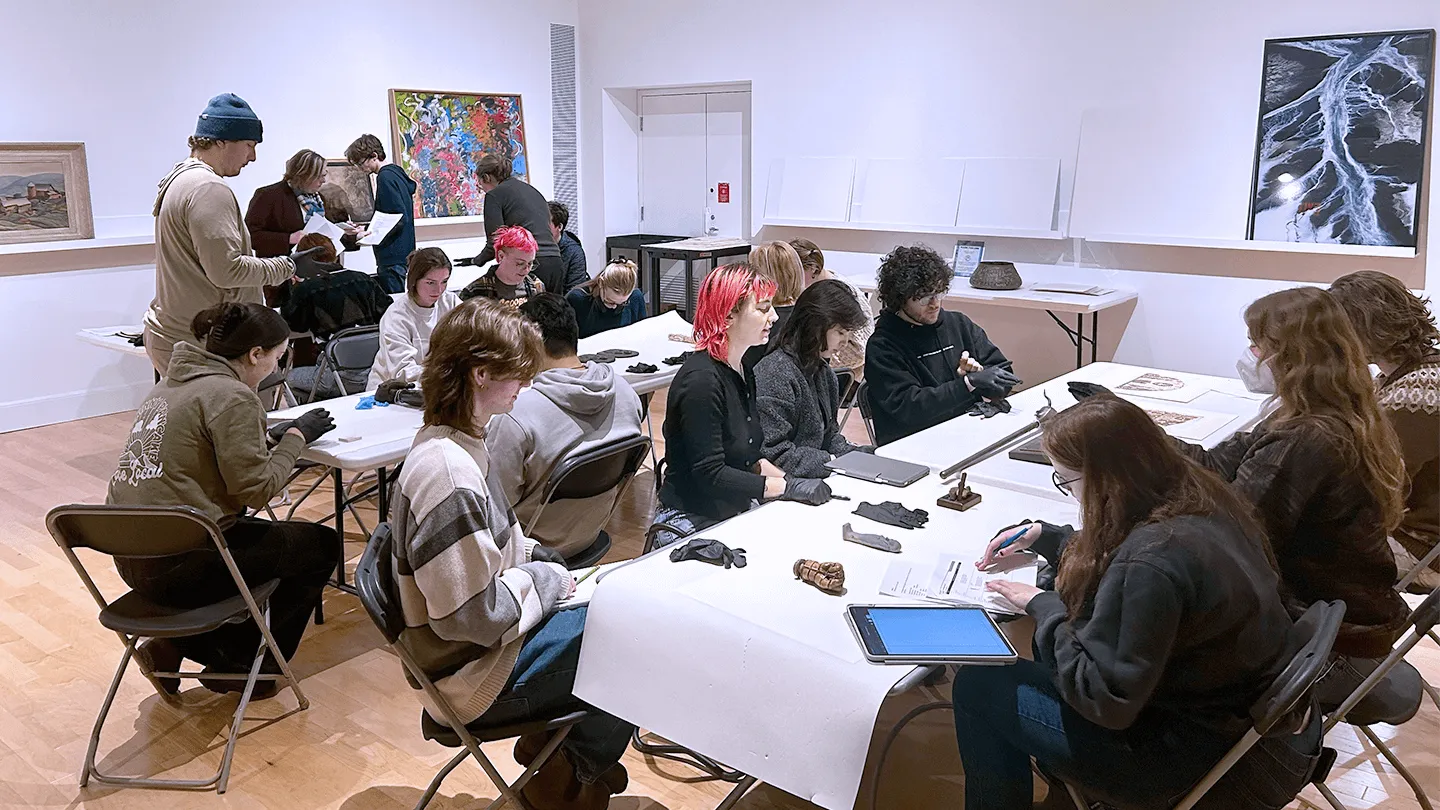History and Anthropology double major Tura Furrow-Scott '25 has engaged with the Fleming Museum of Art in almost every way imaginable. She has been working as a gallery attendant since her sophomore year, visited often for enjoyment or a UVM class—she’s also an Art History minor—and in the Summer of 2024 she was the Fleming’s College of Arts and Sciences Collections and Curatorial Intern.
Under the guidance of Kristan M. Hanson, Curator of Collections and Exhibitions and Margaret Tamulonis, Manager of Collections and Exhibitions, Tura took on a variety of projects, including historical collections research, object handling and documentation, database editing, and label writing. And just this Spring, Tura was able to put those skills to use in Jennifer Dickinson’s, Ph.D., Museum Anthropology class, where she and her fellow students researched several works from the Fleming’s Collections and presented new exhibition proposals to Museum staff.
Could you give us an overview of the projects you worked on during your internship?
Ancient Egypt has piqued my interest since Elementary school, and when I learned that the collections and exhibitions team were planning to display the faience amulet and beads, I knew I wanted to write labels for them. From there I learned more about the Fleming’s ancient Egyptian collection and its history. Primarily, I’ve been creating a timeline of the ancient Egyptian human remains’ exhibition history at the Fleming. This involves looking through museum records, newspapers, and other sources to find dates the remains were either moved, confirmed to be on display, or otherwise studied, such as the X-Rays in 1937 and 2010.
I’ve done explorations of human remains in museums for some of my Anthropology classes, but this was my first time following the history of a specific individual. It really laid out just how much public opinion and paradigms affect display practices. [The ancient Egyptian human remains in the Fleming’s Collections were removed from display in December 2020.] Outside of those projects, I’ve been helping clean up the database, and preparing objects for exhibition in the Collections gallery!
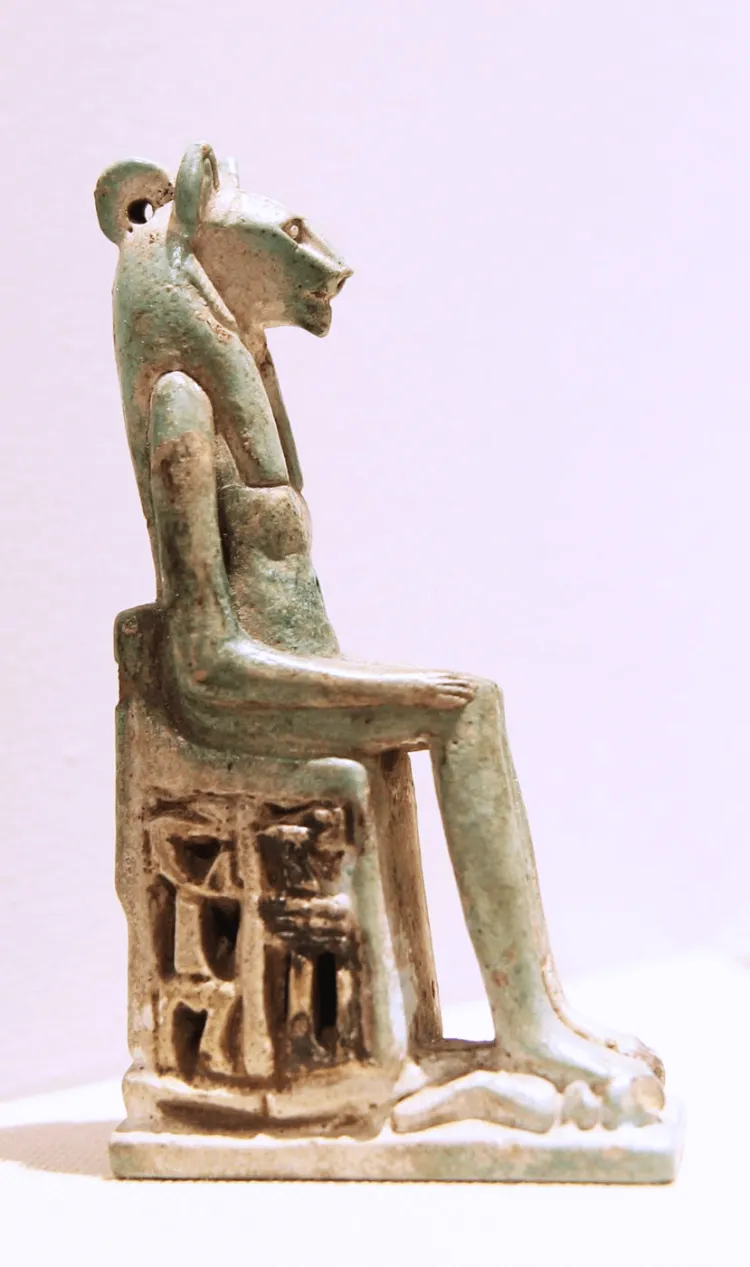
As an intern you have the opportunity to work with art and objects more “up close” than the average visitor, what are your thoughts on that experience?
It’s nerve-wracking, especially the first few times. When you’re holding a piece of history in your hands, whether it be painted or carved, there’s going to be a sense of responsibility around it. But getting a closer look also allows you to see things others wouldn’t. It’s easier to imagine how a necklace might’ve been worn when you can feel the weight of it in your hands. It ultimately got easier, and I’m far more confident now than I was in the beginning—I think that’s the key to it. If you can move objects carefully and confidently, there’s nothing to worry about.
As someone who is studying multiple fields, in what ways do your studies and the research you completed at the museum overlap?
They overlap significantly! My experience writing research papers in my history classes lent itself wonderfully to the research needed for the timeline and the label, and my anthropology and archaeology classes gave me a great amount of background knowledge I was able to apply during my internship. I think this overlap gives me a great amount of fluidity around the museum—if you need someone to help move objects, I know the protocols, but I’m just as comfortable holing up in the library to find that book we saw referenced or that article we forgot to save. I think it helps broaden my skills to be applicable to more opportunities and helps me find alternative perspectives.
After working with the Collections and Exhibitions team, what insights or new perspectives were you able to take away about museum work?
Kristan [M. Hanson, Curator of Collections and Exhibitions] and Margaret [Tamulonis, Manager of Collections and Exhibitions] were lovely and gave me a lot of great advice and encouragement. They helped me better understand their respective jobs and the differences between the two. They helped me fine-tune my research abilities and alter what I’d been taught to suit different needs. I was able to get more comfortable around objects and the “back end” of the museum’s collections, and they let me see overall what their jobs looked like during a time as busy and full of change as this past summer was. It was truly invaluable, and I’m excited to see how their advice carries into my future career.
How are you using the Fleming and its spaces for the Museum Anthropology class?
We’re using the space to discuss every aspect of museum work, from how the space and exhibits shape the visitor’s experience, to how to research the objects in the collection and write museum labels using that research. Everyone has been so welcoming and ready to teach us what goes into museum work, especially as we’re seeing the museum when it’s open as opposed to my work this previous summer.
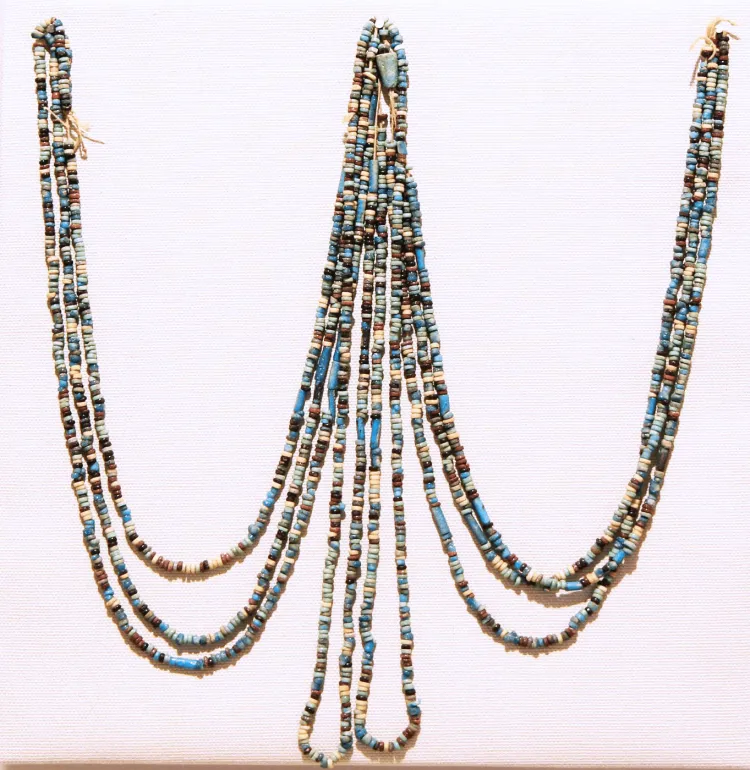
What do you think are the benefits of having a museum on campus?
There are so many! I think the Fleming sometimes gets overlooked by most of the student body, but it’s such a wonderful resource, whether it’s for classes looking for inspiration or in-person examples, students wanting somewhere to study outside of the library, or even just looking at pretty art! In addition, it’s the perfect work study opportunity, as the staff are incredibly welcoming. Even as a student employee, I’ve really felt like a part of the team.
What do you want to pursue after UVM?
An unsurprising answer, but museum work! I’ve grown very fond of working with collections, and I must say, I prefer being indoors to being in the field. Being a curator speaks to me, but I plan to seek out a master’s in museum studies first. This internship has been an all-around fantastic experience, and I think everything I’ve learned will be applicable in some way to my future jobs and studies.
You have seen the Museum from all sides—gallery attendant, intern, student—how do you think that access has shaped your UVM experience?
Frankly, my experiences here at the Fleming have made my college experience. I’m not sure I would have found this path and been as well-prepared for my future within it had Phil [Morin, Manager of Campus and Community Engagement] not taken that chance in hiring me. I’ve made some great friendships with the other student employees, connections with the amazing faculty, and have developed skills that will aid me wherever I end up after I graduate.
What was your favorite thing about interning at the Fleming?
I really enjoyed the research and label writing! It was a fantastic way to implement the skills I’ve picked up during my history and anthropology classes, but in a more manageable (and significantly less stressful) way than the 12-to-20-page essays I’ve had to write. I enjoyed it immensely, and it really affirmed to me that this is what I want to do for the rest of my life. In addition, getting to know all the staff better has been a wonderful part of this experience as well!
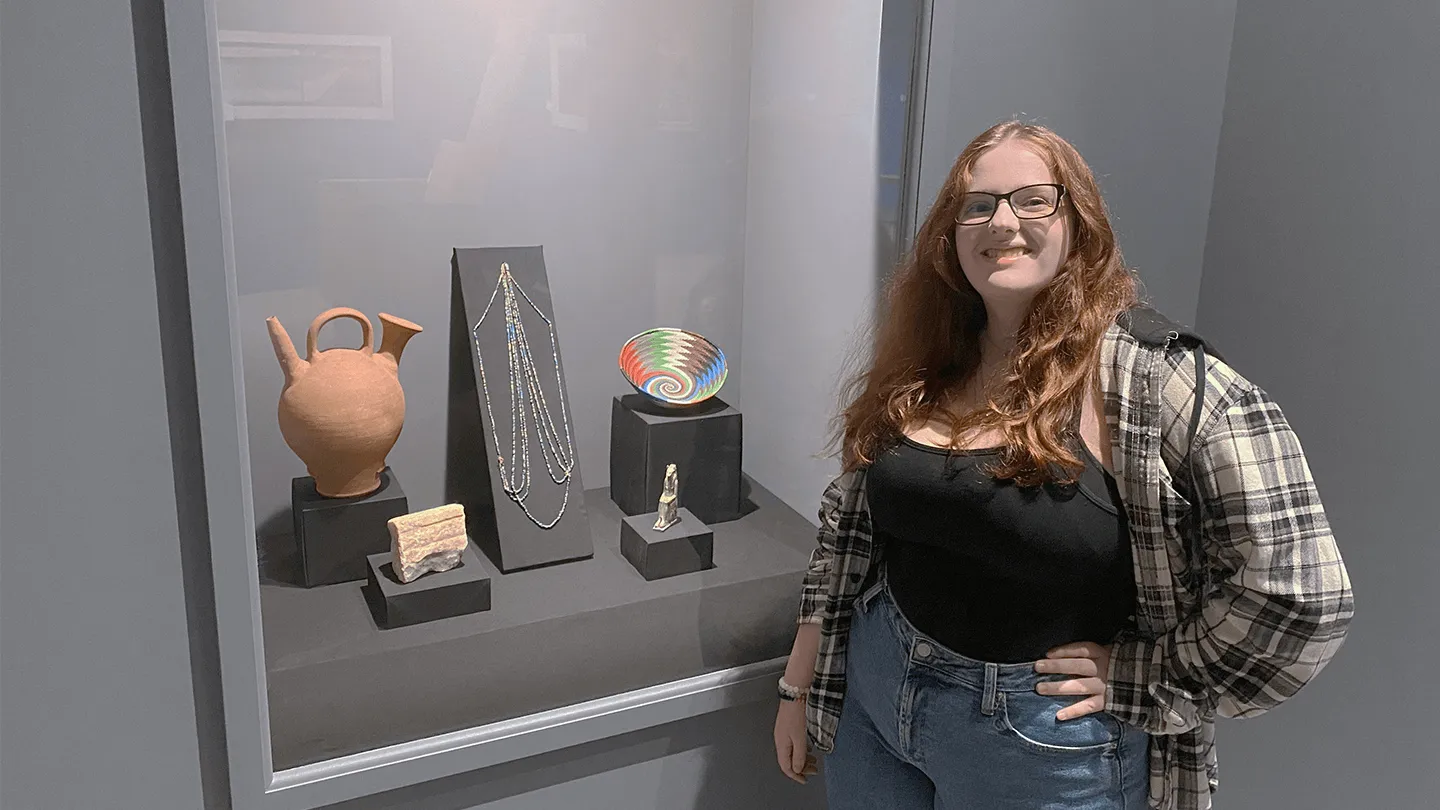
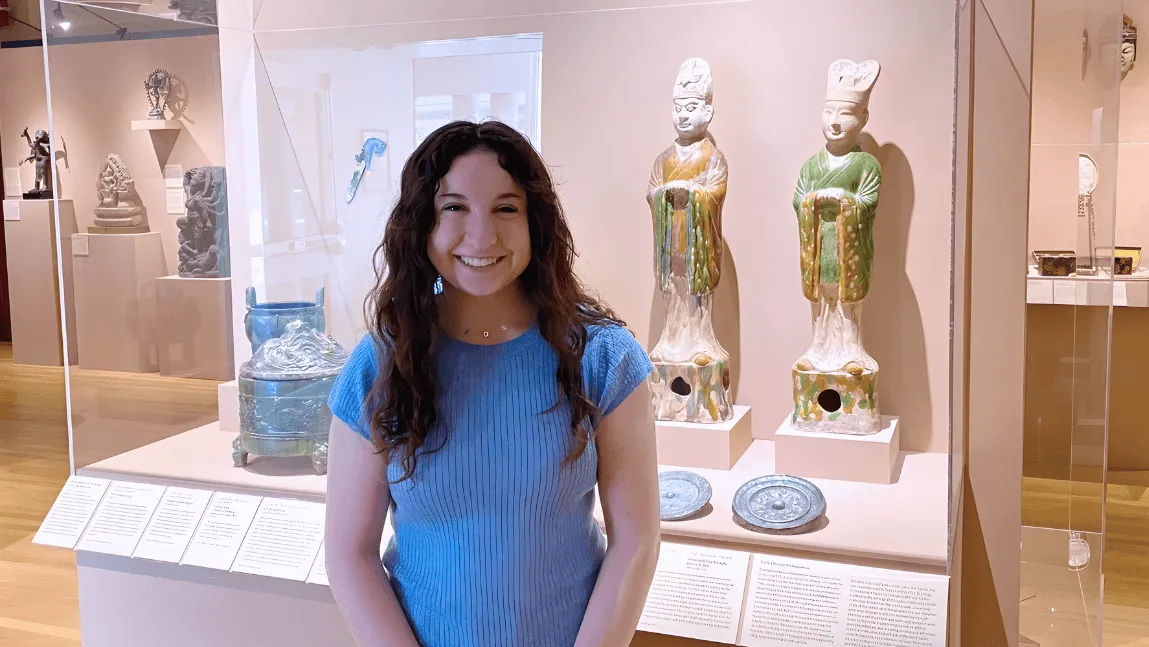
![On the right is Eamon Dunn ’24 as he conducts research on an oil painting, to left is a detail of Untitled [Vincent] an artwork by Alex Katz](/d10-files/styles/default_1920/public/shared/fleming-museum-art/eamon.elmsie.news_.png.webp?itok=AaYBcqgk)
